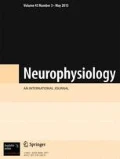Abstract
Experiments on hippocampal slices showed that perfusion with a dextran solution more effectively facilitates AMPA-mediated transmission in structurally complex synapses of mossy fibers of Shaffer collaterals. Estimates for changes in the extracellular Ca2+ concentration in the close vicinity of a reconstructed synapse during the action potential development are obtained. The results together with data about the rather small (0.5 μm) characteristics distance between neighboring synapses showed that the probability of mutual intersynaptic influence via the microenvironment is high. A probable functional role of such influences is discussed.
Similar content being viewed by others
References
R. A. Silver, S. G. Cull-Candy, and T. Takahashi, “Non-NMDA glutamate receptor occupancy and open probability at a rat cerebellar synapse with single and multiple release sites,”J. Physiol.,494, 231–250 (1996).
D. M. Kullmann, G. Erdemli, and F. Asztely, “LTP of AMPA and NMDA receptor-mediated signals: evidence for presynaptic expression and extrasynaptic glutamate spill-over,”Neuron,17, 461–474 (1996).
D. M. Kullmann and S. A. Siegelbaum, “The site of expression of NMDA receptor-dependent LTP: new fuel for an old fire,”Neuron,15, 997–1002 (1995).
J. T. Isaac, R. A. Nicoll, and R. C. Malenka, “Evidence for silent synapses: implications for the expression of LTP,”Neuron,15, 427–434 (1995).
D. A. Rusakov and D. M. Kullmann, “Extrasynaptic glutamate diffusion in the hippocampus: ultrastructural constraints, uptake, and receptor activation,”J. Neurosci.,18, 3158–3170 (1998).
D. A. Rusakov and D. M. Kullmann, “Geometrical and viscous components of tortuosity of the extracellular space in the brain,”PNAS USA,95, 8975–8980 (1998).
M.-Y. Min, D. A. Rusakov, and D. M. Kullmann, “Activation of AMPA, kainate and metabotropic glutamate receptors at mossy fiber synapses in the hippocampus: role of glutamate diffusion,”Neuron,21, 561–570 (1998).
P. R. Montague, “The resource consumption principle—attention and memory in volumes of neural tissue,”PNAS USA,93, 3619–3623 (1996).
J. G. G. Borst and B. Sakmann, “Calcium influx during an action potential,”Nature,383, 431–434 (1996).
D. A. Rusakov, E. Harrison, and M. G. Stewart, “Synapses in hippocampus occupy only 1–2% of cell membranes and are spaced less than half-micron apart: a quantitative ultrastructural analysis with discussion of physiological implications,”Neuropharmacology,37, 513–521 (1998).
D. A. Rusakov, M. G. Stewart, and S. M. Korogod, “Branching of active dendritic spines as a mechanism for controlling synaptic efficacy,”Neuroscience,75, 315–323 (1996).
J. D. Clements, “Transmitter time course in the synaptic cleft: its role in central synaptic function,”Trends Neurosci.,19, 163–170 (1996).
B. Barbour and M. Hausser, “Intersynaptic diffusion of neurotransmitter,”Trends Neurosci.,20, 377–384 (1997).
D. A. Rusakov, D. M. Kullmann, and M. G. Stewart, “Hippocampal synapses: do they talk to their neighbours?,”Trends Neurosci. (1999).
G. G. Skibo, H. A. Davies, D. A. Rusakov, et al., “Increased immunogold labelling of NCAM isoforms in synaptic active zones of the chick striatum 5–6 h after one-trial passive avoidance training,”Neuroscience,82, 1–5 (1998).
W. J. Koroshetz and G. Gonsales, “Diffusion-weighted MRI: An ECG for ‘brain attack’?,”Ann. Neurol.,41, 565–568 (1997).
E. Sykova, “The extracellular space in the CNS: Its regulation, volume and geometry in normal and pathological neuronal function,”Neuroscientist,3, 28–41 (1997).
A. Zador, C. Koch, and T. H. Brown, “Biophysical model of a Hebbian synapse,”Proc. Natl. Acad. Sci. USA,87, 6718–6722 (1990).
D. A. Rusakov and D. M. Kullmann, “A tortuous and viscous route to understanding diffusion in the brain,”Trends Neurosci.,21, 469–470 (1998).
Author information
Authors and Affiliations
Rights and permissions
About this article
Cite this article
Rusakov, D.A., Min, MY., Skibo, G.G. et al. Role of the synaptic microenvironment in functional modification of synaptic transmission. Neurophysiology 31, 79–81 (1999). https://doi.org/10.1007/BF02515039
Issue Date:
DOI: https://doi.org/10.1007/BF02515039



